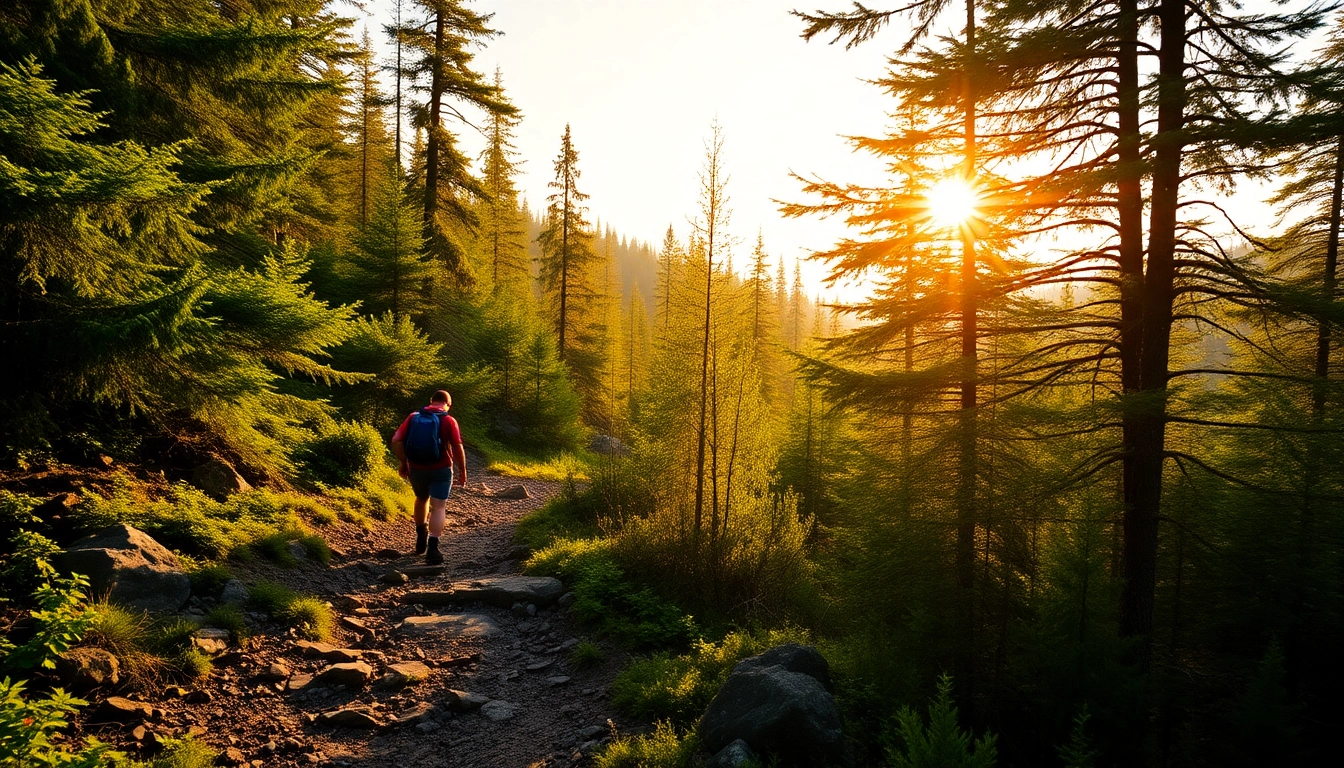
Introduction to Hiking in Indonesia
Indonesia, an archipelago comprising over 17,000 islands, is renowned for its stunning landscapes, diverse ecosystems, and rich cultural tapestry. Among its many outdoor activities, hiking stands out as a favored way for both locals and travelers to immerse themselves in this natural beauty. Whether it’s ascending towering volcanoes, wandering through lush rainforests, or exploring scenic trails along coastal cliffs, hiking in Indonesia offers an unparalleled opportunity to connect with nature while engaging in a healthy, invigorating activity. This comprehensive guide aims to elevate your understanding of hiking in Indonesia, from the benefits and preparation to the top destinations and community resources, ensuring your adventures are safe, enjoyable, and memorable.
Understanding Hiking and Its Benefits in Indonesia
Defining Hiking and Its Distinction from Trekking
Hiking, in essence, involves walking on designated trails or paths for leisure, exercise, or exploration. Unlike trekking, which often entails multi-day expeditions into remote and rugged terrains, hiking in Indonesia typically emphasizes shorter, accessible routes suitable for all levels. According to global sources and expert insights, hiking is characterized by a vigorous walk that promotes physical and mental well-being without requiring extensive logistical planning. While the themes overlap, understanding the nuance between hiking and trekking helps enthusiasts select suitable trails aligned with their skills and objectives.
In Indonesia, hiking activities frequently involve traversing volcanic landscapes, tropical forests, and coastal pathways, each offering a unique experience. These activities are not solely recreational; they carry significant health benefits such as improved cardiovascular health, increased muscle strength, reduced stress, and enhanced mental clarity. Studies have shown that regular outdoor activity like hiking can contribute to better sleep, boost immunity, and foster emotional resilience.
Health and Wellness Benefits of Hiking in Indonesia
The health benefits of hiking extend beyond physical fitness. Engaging with natural environments reduces cortisol levels, mitigates anxiety, and promotes mindfulness. In Indonesia, where lush ecosystems abound, hikers can enjoy the therapeutic effects of breathing clean mountain air, listening to natural sounds, and absorbing scenic vistas. Moreover, hiking encourages social interaction through community groups and guided tours, fostering a sense of belonging and shared purpose.
One compelling aspect of hiking in Indonesia is its contribution to mental health. Recent research indicates that outdoor physical activities like hiking significantly lower symptoms of depression and anxiety. Combined with Indonesia’s tranquil environment and scenic diversity, hiking becomes a holistic activity that rejuvenates both mind and body.
The Popularity of Hiking in Indonesian Nature
Cultural and Environmental Factors Driving Hiking Popularity
Indonesian culture highly values nature and outdoor engagement, partly due to traditional practices rooted in spirituality, agriculture, and communal activities. Over recent decades, increased awareness of outdoor recreation’s health benefits, coupled with the rise of eco-tourism, has amplified hiking’s popularity across the nation.
The country’s breathtaking natural attractions, from the iconic Mount Rinjani to the enchanting forests of Borneo and Sumatra, attract thousands of hiking enthusiasts annually. Additionally, local communities increasingly recognize tourism as a vital economic driver, leading to the development of well-maintained trails, guided tours, and eco-friendly initiatives that support sustainable hiking practices.
Impact of Tourism and Social Media Influences
Social media platforms, particularly Instagram and TikTok, have fueled the popularity of hiking in Indonesia by showcasing captivating images and videos of scenic trails and mountain summits. This digital visibility turns remote or lesser-known spots into trending destinations, encouraging a broader demographic to venture into nature.
Furthermore, the rise of adventure tourism and experiential travel in Indonesia caters to global travelers seeking authentic wildlife encounters and challenging hikes. Local operators and guides provide tailored experiences, ranging from beginner-friendly walks to challenging multi-day treks, reinforcing hiking’s status as a versatile outdoor activity suitable for all interests and fitness levels.
Types of Hiking Trails Suitable for Beginners and Experts
Beginner-Friendly Trails
For newcomers to hiking, Indonesia offers numerous accessible trails that showcase natural beauty without demanding technical skills. Examples include the lush forest pathways in Bali’s Bedugul region, where gentle ascents lead to stunning lake views, or the easy coastal walks in Lombok, where sandy beaches and tropical flora create a relaxing ambiance. These routes often feature well-marked paths, minimal elevation gain, and facilities suitable for families or casual hikers.
Expert-Level Trails and Challenging Expeditions
Experienced hikers seeking a challenge can explore active volcanoes like Mount Merapi or Mount Bromo in Java, or venture into the remote wilderness of Papua’s Trikora Peak. These trails typically involve significant elevation, rugged terrain, and unpredictable weather conditions, necessitating technical skills, proper equipment, and thorough planning. Such expeditions provide adrenaline-rich experiences and rewarding panoramic vistas that test stamina and navigation expertise.
Factors to Consider When Choosing a Trail
- Trail Difficulty and Physical Requirements
- Weather and Climate Conditions
- Local Regulations and Permits
- Availability of Guides and Support Services
- Environmental Sensitivity and Conservation Status
Preparing for Your Hiking Adventure
Essential Gear and Equipment for Indonesian Trails
Proper preparation begins with selecting the right gear. In Indonesia’s tropical climate, lightweight, moisture-wicking clothing, sturdy hiking boots, and rain gear are essential. Additionally, carry a backpack with navigation tools such as maps or GPS devices, sufficient water and hydration systems, sun protection, insect repellent, and basic first aid supplies. For longer expeditions, packing lightweight camping gear, food supplies, and emergency communication devices becomes vital.
Experts recommend investing in quality hiking shoes that provide ankle support and grip, especially for rocky or muddy paths. Equipment like trekking poles can reduce fatigue on steep descents, and lightweight, quick-drying clothing helps manage the humidity and heat typical of Indonesian weather.
Planning Your Route and Safety Measures
Meticulous planning includes studying trail maps, understanding terrain features, and assessing weather forecasts. Engaging local guides enhances safety, provides cultural insights, and ensures adherence to environmental regulations. Always inform a trusted person about your itinerary and estimated return time.
Safety tips encompass carrying sufficient water, avoiding trekking during extreme weather, maintaining communication devices charged, and being aware of wildlife or environmental hazards. In sensitive areas, respecting local customs and securing necessary permits uphold sustainable tourism practices.
Optimal Seasons and Weather Considerations
The ideal hiking season in Indonesia varies regionally but generally coincides with the dry season, from May to September, which offers clearer skies and more stable weather. The rainy season (November to March) presents challenges such as muddy trails, landslides, and limited visibility. Planning hikes during optimal periods minimizes risks and enhances overall experience.
Top Hiking Destinations in Indonesia
Mount Rinjani: Indonesia’s Iconic Trekking Spot
Mount Rinjani, located on Lombok, is famed for its imposing caldera, lush landscapes, and the rejuvenating hot springs. Rising to 3,726 meters, Rinjani offers a multi-day trek that attracts seasoned hikers worldwide. The trail features volcanic craters, waterfalls, and panoramic views at the summit, making it a must-visit for adventure enthusiasts.
Beautiful Forest Trails in Lombok and Bali
Lombok’s Senaru and Sembalun routes traverse verdant rainforests and terraced rice paddies, leading hikers to stunning viewpoints and waterfalls. Bali’s Campuhan Ridge Walk is a more relaxed trail showcasing lush greenery and cultural scenery, perfect for beginners.
Hidden Gems and Less-Traveled Paths
For those seeking solitude and unique experiences, exploring lesser-known trails such as Gunung Tujuh in Aceh or the remote forests of Halmahera can uncover pristine ecosystems and untouched landscapes. These paths often require more meticulous planning but reward explorers with pristine wilderness and authentic encounters.
Enhancing Your Hiking Experience
Staying Fit and Preparing Physically
Physical preparation involves cardiovascular training, strength exercises, and flexibility routines. Incorporating stair climbing, hiking on varied terrains, and endurance workouts helps build stamina. For multiday hikes, tailored training programs that simulate trail conditions improve performance and reduce injury risk.
Environmental Responsibility and Leave No Trace Principles
Hikers play a critical role in preserving Indonesia’s fragile ecosystems. Adhering to Leave No Trace guidelines—such as disposing of waste properly, avoiding damage to vegetation, and respecting wildlife—ensures sustainable tourism. Participating in trail clean-up activities and supporting eco-friendly businesses further promotes environmental stewardship.
Capturing Memories and Sharing Your Journey
Documenting your hike through photography, journals, or social media fosters appreciation and awareness. Respect local cultures and seek permission when photographing communities or sacred sites. Sharing stories can inspire others and promote conservation efforts.
Hiking Community and Resources
Local Hiking Groups and Guided Tours
Indonesia boasts numerous local clubs, tour operators, and guides specializing in safe, culturally respectful hiking experiences. Joining these groups offers social support, safety assurance, and access to expert knowledge about trails, weather, and environmental considerations.
Useful Apps and Navigation Tools
Modern technology enhances safety and navigation. Applications such as Maps.me, Gaia GPS, and local trekking apps assist with route planning, offline maps, and real-time positioning. Always carry backup devices and offline maps when venturing into remote areas.
Continuing Education and Skill Development
Enhance your outdoor skills by attending workshops, training sessions, and reading authoritative resources. Learning first aid, outdoor cooking, and environmental conservation increases your confidence and helps contribute positively to outdoor communities.
